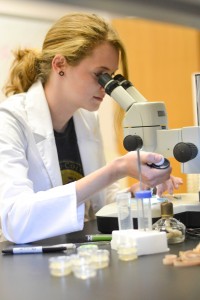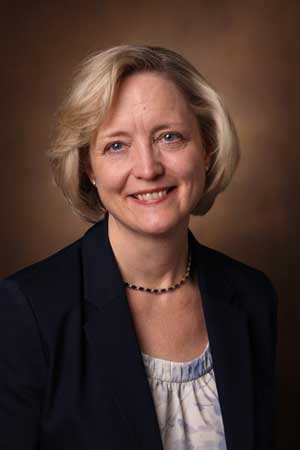Story by Bailey Bohannan, Staff writer

While Murray State’s campus has three female students for every two male, that ratio doesn’t translate into many of the science, technology, engineering and math classes.
“There is generally a lack of women in the scientific workforce throughout the country; the numbers are low in proportion to men,” said Maeve McCarthy, professor of mathematics at Murray State.
Susan Wente, provost at Vanderbilt University, said the lack of women in those areas – known as STEM – is possibly because of a lack of encouragement from family and mentors and the lack of involvement of women in the STEM programs at a younger age. Wente is also a professor of cell and developmental biology.
This is a national issue as well. According to a 2014 U.S. Bureau of Labor Statistics Report, women in the field of computer and mathematical occupations accounted for 26.1 percent of the workforce. Of all U.S. workers in chemistry and material sciences, 39 percent were women. Only 14.4 percent of engineers were women, according to the bureau’s “Women in the Labor Force: A Databook” report.
This imbalance in gender in the STEM programs is potentially hampering progress in those industries, said Wente, who led a seminar at the Curris Center on Monday about “How to Open Doors to Discovery in Scientific Careers.”
“The diverse perspectives that women will bring to the field will lead to innovations and discoveries that may not otherwise happen,” Wente said.

At Murray State, only 17 percent of the 93 faculty members in the science, engineering, and technology departments are women, according to the Office of Institutional Effectiveness in the 2013-14 academic year – the most recent year for which statistics are available.
McCarthy is one of seven women in her department of 27 lecturers and professors. She said she sees the lack of women in STEM as an international problem and there are steps that need to be taken in order to get women more involved in the STEM program, including getting girls involved at a young age and providing supportive mentors throughout their education.
McCarthy said she thinks that the more young girls and young women are involved in STEM programs, the more women will be involved at the college and career level. Murray State has a program called Murray Elementary Girls STEM Club in which college students go to second grade classes and host science experiments in order for the young girls to be more interested in science.
Both McCarthy and Wente said support from mentors and family is a key factor for women who want to get involved in sciences.
Wente said she would identify the turning point when many girls turn away from STEM programs is typically middle school to early high school. She said teachers can be the best influence for girls at this age and then the parents and family supporting the female student.
As a high school teacher for seven years, Pamela Guerrero, Murray State graduate student, said, she has taken notice of the ratio between women and men in her advanced high school classes throughout the years. She said there always seems to be fewer girls taking her classes; however, the few who do generally perform better than the other males in the class.
Guerrero said she thinks being a female math and science teacher at the high school level helps her female students feel as though they too could join the STEM program. She said not only could females bring a new perspective to the field – as could any other form of diversity in the STEM program – but she said women tend to not have as much pride, they explain their ideas and thoughts in more gentle ways, are more helpful and organized, and are more of a caretaker than men are, and would therefore bring new meanings to the workings of the STEM program and its studies and research.
Both McCarthy and Wente said they have felt the pressure that they are the minority in classrooms and conferences throughout their career.
This has never impaired either of them in their studies; however, McCarthy said that the social aspect within her field has been the biggest barrier put against her, with the lack of women colleagues such as dinner after work and activities after conferences.
“I never felt like I couldn’t do what I wanted to do and achieve what I wanted to achieve; it was always more of the social interaction,” McCarthy said. “Whether it is a gender statistic or a racial statistic, whatever minority you might be, if you’re the only person in the room of a specific category, you feel it, you know it.”
McCarthy and Wente said they try and be the best mentors that they can be to young women in the STEM program by supporting their students and encouraging them to press on in the field. Even if it feels as though they aren’t making substantial progress, they keep on encouraging their students.
“Keep going until somebody tells you ‘no,’” Wente said. “You can always try and read into ‘Oh, I’m not going to do it because they might not hire me or they might not take me.’ But if you just keep aiming high and loving what you’re doing, don’t stop until someone tells you ‘no’ many times.”